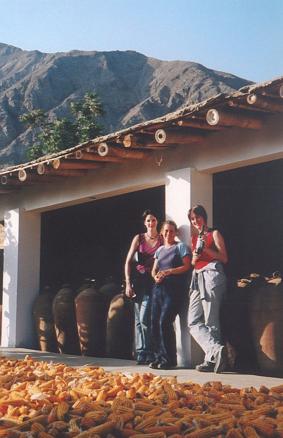21 October 2002: Lima, Peru
Subject: Peru
Greetings from Peru. We've been her for four days and have explored the city a bit and today ventured out into the countryside. Here's the story so far.
Lima
I was preparing myself for a place like Mexico City, but actually Lima seems much quieter and more pleasant. On our first morning we made our way into the center (we are staying in the posh suburb of Miraflores) and within minutes had met lots of friendly people wanting to practice their English on us, including a tourism studies student and a big group of schoolchildren (and it wasn't a scam). Then we did a tour of the Cathedral, which was great. Lima was flattened by an earthquake in 1746 and they say it hasn't regained its previous grandeur, and the cathedral building is not extra-special, but it does contain some lovely chapels. But the highlight is the museum, containing Peruvian religious paintings in a style that features the most extraordinary frames. One actually had glazed compartments full of dried flowers in the frame! Then their were some lovely nativities; they start out like big chests, and open out to reveal all the usual Christmas characters, with the odd llama thrown in for good luck, and in one case the Garden of Eden too!
We've been to a couple of the archaeological museums, and they do have some lovely things: the pre-columbian ceramics are wonderful. Then there are the textiles, which are of course of special interest to Christine who has done dying, spinning and weaving herself. They have some great and very well preserved pieces, including some with brightly-coloured feathers woven in. One of the pre-Inca cultures made the most extraordinary three-dimensional scenes with woven dolls doing day-to-day activities, such as weaving.
Of course there are lots of modern-day handicrafts to look at too, and we have spent more than a while in the craft shops...
Guinea Pigs in Lunahuana
Our time in Lima has been greatly enhanced by my friend Louise, who has been here for some time working - mostly voluntairly - for various development and human-rights groups. Her first job here was related to guinea pig farming; they were helping small farmers to develop their back-yard-scale guinea pig farms. So today she suggested that we should escape from Lima and see the countryside, near the guinea pig farming town of Lunahuana.
So four of us - Christine and I, Louise and her English friend Charlie got up early this morning for the trip. Getting there involves a 150km coach jorney South down the coast to Canete, a minibus across town, then about 60km inland in a collective taxi. The scenery down the coast is very dry; inland it is a stone desert, mostly round water-washed pebbles, suggesting an uplifted seabed. The sea looks to be gently-shelving with waves breaking quite a long way out, just like the surfers like them. And at one point I saw quite a big natural arch. Heading inland it is mostly still dry, with very bare hillsides, but there is a reasonable-sized river (in which we dipped our feet) and the valley bottom is cultivated.
So we stopped for lunch at one of the places where Louise's group had been involved. They had started from next-to-nothing - the man had been slightly injured and was not up to hard-graft farming any more - and were now breeding guinea pigs and rabbits for meat and also to sell as breeding stock. Then his wife runs a restraunt and caters for parties of up to two hundred guinea pig eaters! So the four of us were no trouble. And yes, guinea pig is very tasty. Its main problem is that it has lots of small bones that make eating it rather tedious. But apparently it is very nutritious, so that's yet another benefit that the community gets from the enterprise.

One of the crops they grow in the valley is Medler Fruit - if we have the right translation - and we got a plate of them for desert. I've never seen them before - they are the size of a small apricot and have white flesh, a bit like a lychee I suppose, around two or three seeds. Delicious. They also grow grapes, and after lunch we visited a local winery where they make wine and also distill it to make some rather nice fortified wines (and some less lovely ones). They were storing them in some remarkably rustic looking vessels that you would think were roman amphoras if you saw them in a museum!

A lovely day out - though it's a shame you have to go such a long way to get to somewhere nice.
So now we have to decide what to do next: probably a trip northwards to Huaraz, from where we should be able to see some mountains!